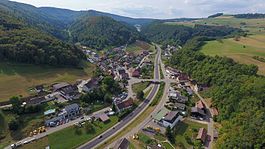Bargen, Schaffhausen
| Bargen | ||
|---|---|---|
 |
||
|
||
| Coordinates: 47°47′N 8°36′E / 47.783°N 8.600°ECoordinates: 47°47′N 8°36′E / 47.783°N 8.600°E | ||
| Country | Switzerland | |
| Canton | Schaffhausen | |
| District | n.a. | |
| Government | ||
| • Mayor | Erich Graf (as of 2012) |
|
| Area | ||
| • Total | 8.27 km2 (3.19 sq mi) | |
| Elevation | 605 m (1,985 ft) | |
| Population (Dec 2015) | ||
| • Total | 291 | |
| • Density | 35/km2 (91/sq mi) | |
| Postal code | 8233 | |
| SFOS number | 2931 | |
| Localities | Oberbargen | |
| Surrounded by | Blumberg (DE-BW), Merishausen, Tengen (DE-BW) | |
| Website |
www Profile (German), SFSO statistics |
|
Bargen is a municipality in the canton of Schaffhausen in Switzerland. The northernmost point of the country is situated in the municipality, at Oberbargen.
Bargen is first mentioned in 884 as Paragen.
Bargen has an area, as of 2006[update], of 8.3 km2 (3.2 sq mi). Of this area, 29.2% is used for agricultural purposes, while 65.8% is forested. Of the rest of the land, 4.8% is settled (buildings or roads) and the remainder (0.2%) is non-productive (rivers, glaciers or mountains).
The municipality is located in the Schaffhausen district. It is a farming village on the northernmost point of Switzerland. The municipality includes a notable protected natural area, Tannbüehl, which is known for its over 20 varieties of orchids.
Bargen has a population (as of 2008[update]) of 249, of which 12.4% are foreign nationals. Of the foreign population, (as of 2008[update]), 60% are from Germany, 22.9% are from Italy, 11.4% are from Croatia, and 5.7% are from another country. Over the last 10 years the population has decreased at a rate of -2.1%. Most of the population (as of 2000[update]) speaks German (96.0%), with Italian being second most common ( 1.6%) and Serbo-Croatian being third ( 1.2%). There is also a small but significant population of Poles. (0.23)
The age distribution of the population (as of 2008[update]) is children and teenagers (0–19 years old) make up 18.9% of the population, while adults (20–64 years old) make up 59.8% and seniors (over 64 years old) make up 21.3%.
...
Wikipedia




